The Differences Between Hard And Soft Shell Clams
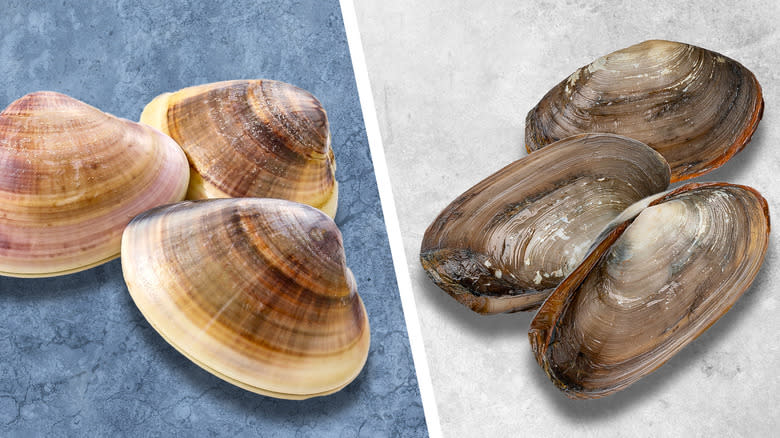
Clams are one of the cheapest shellfish you can get, and super simple to cook at home. You're probably most familiar with hard-shell clams, the ones that open to reveal soft pieces of clam meat on the inside. But have you heard of soft-shell clams? You can eat soft shell-clams with very little cooking and have a tender, delicate seafood perfect as an appetizer. Hard-shell clams are a little more hardy and more commonly cooked for longer periods of time.
While they may mostly look the same there are some key differences between hard and soft-shell clams that distinguish the two shellfish. Knowing the best ways to cook these clams allows you to fully enjoy their depth of flavor. Soft-shell clams are not as common as their hard-shell counterparts and may sound off-putting at first, but they are considered a delicacy in the Chesapeake Bay region.
Read more: 15 Different Ways To Cook Fish
What Are Soft-Shell Clams?
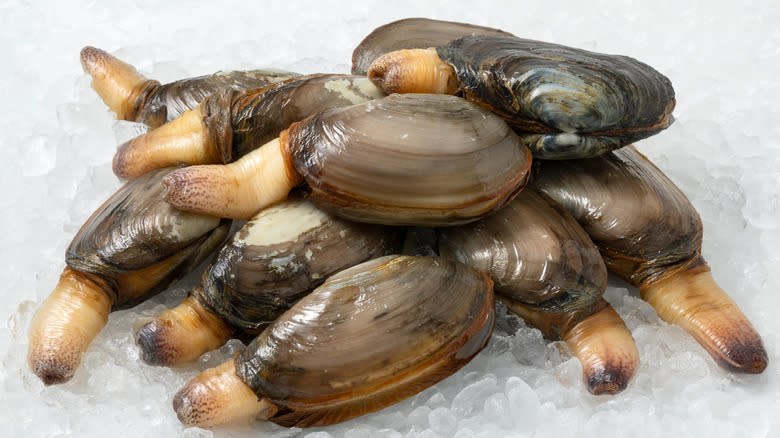
Soft shell clams are, as the name suggests, clams with softer shells. These shells aren't malleable or squishy, instead, they are thin and brittle. Soft-shell clams are sometimes called steamer clams, referring to one of the most popular ways they're prepared. Soft-shell clams can be found along the east coast from Canada to the Carolinas, and also in some areas of the west coast.
The clams have an oval shape and are about three to four inches in length. The outer shell comes in a brownish-gray color. The siphon, which is the meat part in clams, can not fully retract into the shell of soft-shell clams. The length of the siphon prevents soft-shell clams from being able to fully close their shells, this results in soft-shell clam meat sometimes being tougher when compared to hard-shell clams. Unlike some other types of seafood, a broken shell on the soft-shell clam does not necessarily mean they are no longer good to eat, just use caution and be sure to check clams over before eating.
What Are Hard-Shell Clams?
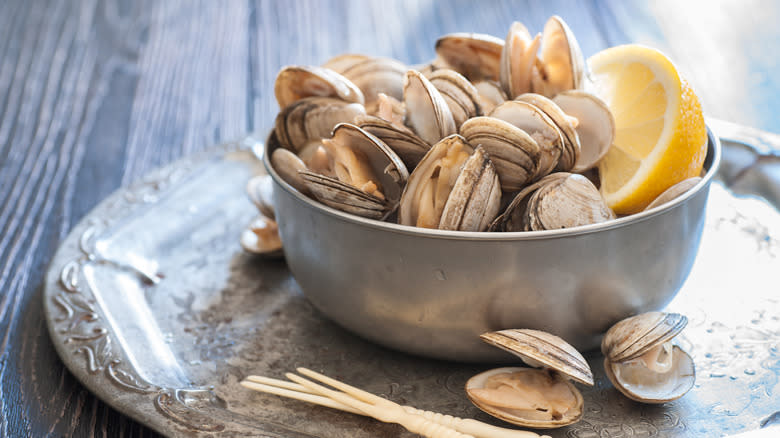
Hard-shell clams are more common than their soft-shell counterparts. If you go to the seafood portion of your supermarket, you'll most likely see an iteration of hard shell clams for sale as they are the most common types sold commercially. Hard-shell clams can vary in size, and different sizes of hard-shelled clams will be used for different purposes. You can typically find hard-shell clams from Nova Scotia, all the way down to the coast of Florida. These clams have softer meat, with some of the variations being particularly known for their tender meat like the little neck clams.
Appearance-wise, hard-shell clams are rounded and also a brownish, gray color. These clams also have ridges on their shells. They typically come in around four inches but can grow larger. Most frozen or canned clams are hard-shell clams as well. Since these clams can fully close their shell the meat is easier to cook in a variety of ways. Hard-shell clams are sold based on size with little necks being the smallest and most expensive, cherry stones are medium-sized, and chowder clams which are the largest and cheapest of the hard-shell varieties.
How Soft-Shell Clams Are Cooked And Served
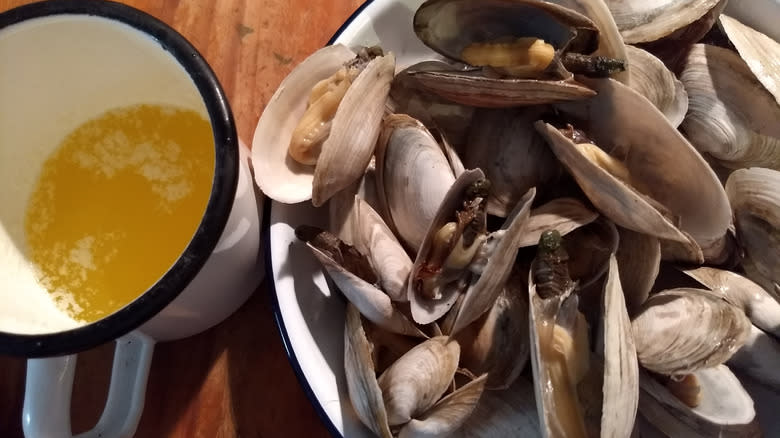
The secondary name for soft-shell clams, steamer clams, indicates the most traditional way these clams are served. You can steam these clams in water or in beer for a more complex flavor. The clams can then be topped with melted butter. Steaming the clams is an easy way to soften up the tougher meat of the soft-shell clams. The proper way to eat a steamed soft-shell clam is to peel off the skin covering the meat, give your clam a quick swish in the broth to clean it off, then enjoy. You can spice up your steamed clams by experimenting with different beer steams and adding herbs and spices to your steaming broth.
Soft-shell clams can also be prepared fried but keep in mind they may be a little chewy. To enjoy fried soft-shell clams, start by steaming the clams to open the shells. Then dip your clam meat into a wet batter, fry until golden, and enjoy. You won't typically find soft-shell clams in dishes that need tender clam meat like chowders and fritters.
How Hard-Shell Clams Are Cooked And Served
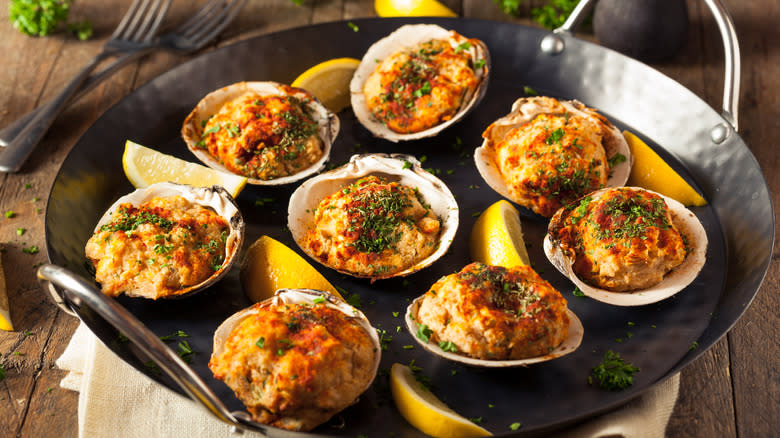
There are an abundance of ways to serve up hard-shell clams. The size of the clam will determine the best way to be cooked and served. Little neck clams are going to shine in dishes where you can taste the clam meat. Little neck clams are often enjoyed raw on the half shell with lemon, or steamed in paellas. The tender, sweet meat makes these small clams incredibly desirable.
The cherrystone clams are a great size for being stuffed with a savory breading mixture and baked till lightly crispy. These medium-sized clams are also commonly enjoyed steamed and tossed into a pasta dish. These are the most versatile of the hard-shell clams and are generally enjoyable however you serve them. You can also grill these clams for a smoky take on the shellfish.
Chowder clams are, as the name infers, great for chowders. The large size of these clams allows for ample meat to be chopped up and used in the iconic clam-based dish. The briny flavor of these clams pairs excellently with the creamy chowder. Chowder clams can also be enjoyed pounded out and turned into a clam fritter. Clam fritters are similar to fried clams but similar in texture to a hushpuppy.
How To Properly Store Soft-Shell Clams And Hard-Shell Clams
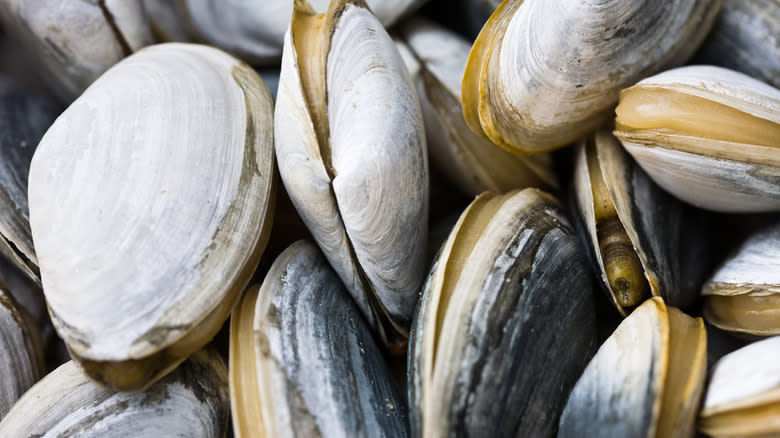
When working with live clams, both hard-shell and soft-shell varieties are stored similarly. After purchasing your clams you should keep them over a bed of ice until you can get them into refrigeration. Once you have transported the clams to where you'll be preparing them you should place them in the fridge in an open container. Place a breathable cloth on top to help retain moisture. You should never store selfish soaking in water, this can cause harmful bacteria to grow.
All shellfish should be cooked within 24 hours of purchase, ideally on the same day. If you are unable to use your hard-shell clams within this time frame you can always opt to freeze them. Clam meat can be frozen, shucked, or unshucked. To freeze clams in the shell, clean the clams under cold water. Thoroughly dry off your clams and transfer them into an airtight container or plastic bag. When freezing clams it's important to only freeze clams with a closed shell to ensure they stay safe to eat. Thus, freezing soft-shell clams isn't an option. Frozen clams can last for up to three months if stored properly.
Read the original article on Tasting Table.

